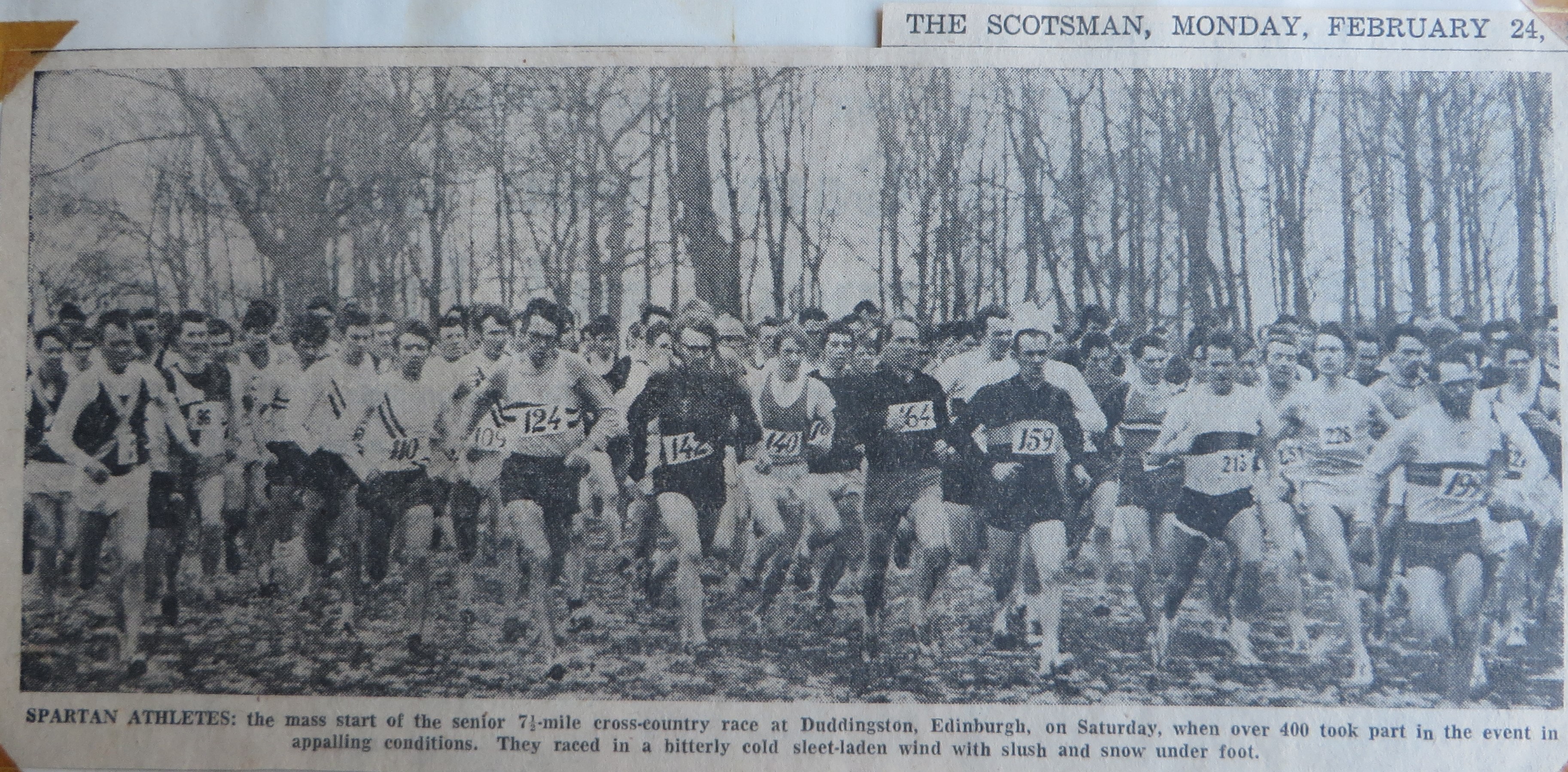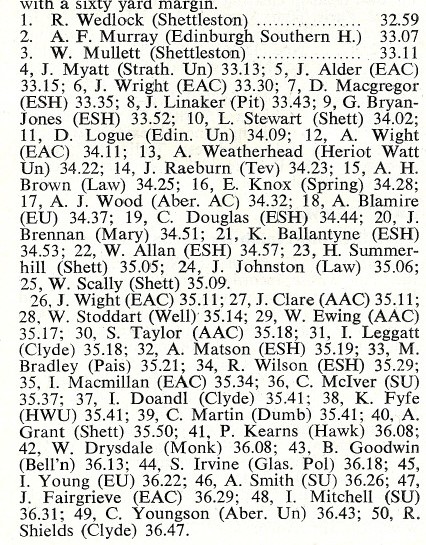It’s a good picture shown above – but it doesn’t show the weather conditions that the competitors had to endure. Held on 22nd February 1969, the race was run over 5 laps on the Duddingston Golf Course in Edinburgh. The five laps tell a tale – I have seldom run a senior cross-country race over 5 laps, and to pass your warm tracksuit at each of the first four laps here was a great temptation to drop out. Many took the chance but it is a tribute to all the finishers – in all the age groups – that they did master the difficulties.
The race was organised by the SCCU with its usual efficiency and all the experienced and qualified officials were in place for the afternoon. They had to stand for all the races – and there was a total of five races to keep them occupied in the cold and sleet. There were 1237 entries on the programme (422 senior men) and 605 finishers (196 senior men). Although the number of entries does not equal the number of starters in any race, the fact that less than half those entered finished does tell a tale. It had been a week of really bad weather – the front page of the Friday “Herald” had a picture of the Duke of Edinburgh striding through a blizzard when he visited the site for the Commonwealth Games the following year. We are told that he was greeted by “driving snow”. The overnight weather in Edinburgh was freezing cold. How did the race go then?
The basics were reported in the “Glasgow Herald” on the following Monday, reprinted in its entirety below.
WEDLOCK’S SCOTTISH TITLE VICTORY BY 45 YARDS
Dick Wedlock (Shettleston) won the Scottish senior cross-country title at Duddingston Park, Edinburgh, on Saturday when he covered the seven and a half miles in 32 min. 59 sec. AF Murray (Edinburgh Southern) was second, 45 yards back behind, and W Mullett, an Anglo-Scot running in Shettleston’s colours, was a further 20 yards away in third place.
“Wedlock shared the lead with JN Alder (Edinburgh AC) after three laps of the five lap race, five yards ahead of J Wright (Edinburgh AC). They were followed by Mullett and Murray. With one lap left Wedlock was out in front, and the holder, JL Stewart (Shettleston) looked tired in eighth position. Stewart, however, had not completely recovered from a bout of influenza, and did well to finish in 10th position.”
Which is fine as far as it went.
What made it different?
First it was the dire weather. Colin Shields described the course as “icy, rutted and rock hard after a bad spell of weather.” Colin was being polite because he is a gentleman. Athletics Weekly gives a more detailed description: The Scottish 7 Miles cross-country championship was run over a park that closely resembled a half-frozen lake as a result of a quick thaw earlier the same day. In conditions that were atrocious for athletes, officials and spectators alike, Ian McCafferty was a non-starter and Alistair Blamire had only recently resumed training after illness.” And note the comment below the photograph above:” They raced in bitterly cold, sleet laden wind with snow underfoot.”
So the weather was bad, although the other word above, “appalling”, might be better. Runners were wearing jerseys, even track suit or wet suit tops under their club vests, many wore gloves and some wore woolly hats.
Then there was the course itself. Cross-country does not often find itself run over five laps. Runners don’t like running in small circles, and in the Duddingston instance with awful weather, it was cruelty to make the athletes pass their warm tracksuits and wetsuits four times in the course of the race. There were not a few who succumbed to the temptation.
It was also basically flat but in the absence of natural cross-country obstacles, there were pairs of steeplechase barriers placed side-by-side to be leapt, clambered over or ducked under. No runner liked them – in one English national in the 1960s there was a similar arrangement and Jim Hogan slipped through between the two barriers only to be disqualified. His defence was that in a cross-country race you can negotiate any obstacle as you please. However that may be, the rush at the start in Edinburgh pushed over one of the two barriers, and the competitors then went through that side. An official, I believe it was Harry Quinn, was sent to tell the runners to ignore the barrier that had been knocked over and instead cross the one that remained upright. It was a losing battle – after all, he was outnumbered.
After all that, what was the result of the race?
It was not a day for the faint hearted, but spare a thought for the officials who had to stand for all five races: at least the runners only had to run the one race before heading for the changing room and a warm drink. It was one of the most uncomfortable days for the national that most of us had ever experienced. Well done to all who took part.

